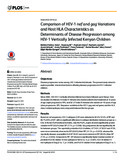Comparison of HIV 1 nef and gag Variations and Host HLA Characteristics as Determinants of Disease Progression among HIV1 Vertically Infected Kenyan Children.

View/
Date
2015-08Author
Saina, MC
Bi, X
Lihana, R
Lwembe, R
Ishizaki, A
Panikulam, A
Palakudy, T
Musoke, R
[et al.]
Language
enMetadata
Show full item recordAbstract
OBJECTIVES:
Disease progression varies among HIV-1-infected individuals. The present study aimed to explore possible viral and host factors affecting disease progression in HIV-1-infected children.
METHODS:
Since 2000, 102 HIV-1 vertically-infected children have been followed-up in Kenya. Here we studied 29 children (15 male/14 female) who started antiretroviral treatment at <5 years of age (rapid progressors; RP), and 32 (17 male/15 female) who started at >10 years of age (slow progressors; SP). Sequence variations in the HIV-1 gag and nef genes and the HLA class I-related epitopes were compared between the two groups.
RESULTS:
Based on nef sequences, HIV-1 subtypes A1/D were detected in 62.5%/12.5% of RP and 66.7%/20% of SP, with no significant difference in subtype distribution between groups (p = 0.8). In the ten Nef functional domains, only the PxxP3 region showed significantly greater variation in RP (33.3%) than SP (7.7%, p = 0.048). Gag sequences did not significantly differ between groups. The reportedly protective HLA-A alleles, A*74:01, A*32:01 and A*26, were more commonly observed in SP (50.0%) than RP (11.1%, p = 0.010), whereas the reportedly disease-susceptible HLA-B*45:01 was more common in RP (33.3%) than SP (7.4%, p = 0.045). Compared to RP, SP showed a significantly higher median number of predicted HLA-B-related 12-mer epitopes in Nef (3 vs. 2, p = 0.037), HLA-B-related 11-mer epitopes in Gag (2 vs. 1, p = 0.029), and HLA-A-related 9-mer epitopes in Gag (4 vs. 1, p = 0.051). SP also had fewer HLA-C-related epitopes in Nef (median 4 vs. 5, p = 0.046) and HLA-C-related 11-mer epitopes in Gag (median 1 vs. 1.5, p = 0.044) than RP.
CONCLUSIONS:
Compared to rapid progressors, slow progressors had more protective HLA-A alleles and more HLA-B-related epitopes in both the Nef and Gag proteins. These results suggest that the host factor HLA plays a stronger role in disease progression than the Nef and Gag sequence variations in HIV-1-infected Kenyan children.
URI
http://journals.plos.org/plosone/article?id=10.1371/journal.pone.0137140http://www.ncbi.nlm.nih.gov/pubmed/26317223
http://hdl.handle.net/11295/91595
Citation
PLoS One. 2015 Aug 28;10(8):e0137140.Publisher
University of Nairobi
